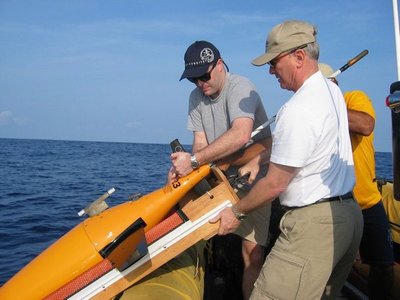April 5, 2005
Pairs of Seagliders set endurance records
Two ocean-diving gliders built at the University of Washington were retrieved late last month near the Hawaiian island of Kauai after setting a world record by traveling a quarter of the way across the Pacific Ocean. Two other UW gliders, awaiting retrieval from the Labrador Sea, have set another world endurance record with a deployment of 193 days as of early April.
The gliders set new marks for autonomous — or unmanned — underwater vehicles. Named “Seagliders” by their developers and builders at the UW’s Applied Physics Laboratory and School of Oceanography, the UW gliders are sleek, torpedo-shaped vehicles some six feet long. They move through the water without propellers, repeatedly diving to collect oceanographic measurements.
Gliders in general have the longest range of any autonomous underwater vehicles yet developed. Unlike floats used for oceanography that drift where ocean currents take them, gliders can be told to hold their positions or change direction by pilots using computers on land — in some cases, more than a thousand miles away.
The Seagliders used in the Pacific Ocean were deployed in the water mid-way between California and Hawaii last September. They traveled the Pacific for 191 days, covering 1,860 miles. During that time one made 599 dives and the other 559.
“Gliders are essential to solving many of our ocean observing problems,” says Bruce Howe, oceanographer with the UW’s Applied Physics Laboratory and principal investigator for work using the Seagliders in the Pacific as part of the North Pacific Acoustics Laboratory project. The project of ongoing experiments, a collaboration between the UW’s Applied Physics Laboratory and Scripps Institution of Oceanography, is funded by the Office of Naval Research.
The temperature, salinity and oxygen data gathered by the Seagliders will help the North Pacific Acoustics Laboratory scientists better understand acoustic propagation — how sound is affected as it moves through the ocean. Acoustics can be used to probe such things as long-term ocean temperature changes and climate variability, and the role of internal waves in ocean mixing, Howe says.
Gliders also could be used to monitor changes in the world’s oceans because of storms, such as hurricanes, and other natural events, such as El Niño. Sonar and other sensing devices mounted on gliders may one day routinely scan harbors and seaports for explosive mines or detect divers in areas where they don’t belong.
A Seaglider can dive from the surface down 3,300 feet and back up every 3 to 9 hours. It remains at the surface 5 minutes to transmit ocean data that it has collected, relay its position and receive instructions via the Iridium satellite phone network, before diving again. It travels at half a knot, driven not by a spinning propeller but by buoyancy control: a hydraulic system moves oil in and out of an external rubber bladder to force the glider up or down through the ocean. Moving its battery pack causes it to pitch its nose up or down or roll its wings to change compass heading.
In the recent deployment in the North Pacific, UW engineers Jim Luby and Neil Bogue piloted one Seaglider on a direct course to Kauai, while the other was sent to gather data for 620 miles due west before being nudged southwest toward Kauai. Both were navigated around Kauai to where UW Applied Physics Laboratory’s Jim Mercer and Jason Gobat led a team to retrieve them.
###
For more information:
Howe, UW Applied Physics Laboratory, 206-543-9141, howe@apl.washington.edu
About Seagliders: http://www.apl.washington.edu/projects/seaglider/summary.html



